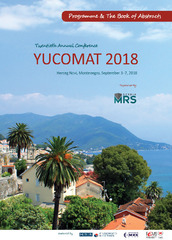Приказ основних података о документу
Improvement of Biocompatibility by Formation of Nanotubular Oxide Layer on the Ultrafine Grained Ti-13Nb-13Zr Alloy
| dc.creator | Đokić, Veljko | |
| dc.creator | Barjaktarević, Dragana | |
| dc.creator | Veljović, Đorđe | |
| dc.creator | Dimić, Ivana | |
| dc.creator | Kojić, Vesna | |
| dc.creator | Rakin, Marko | |
| dc.date.accessioned | 2022-11-22T11:36:52Z | |
| dc.date.available | 2022-11-22T11:36:52Z | |
| dc.date.issued | 2018 | |
| dc.identifier.isbn | 978-86-919111-3-3 | |
| dc.identifier.uri | http://TechnoRep.tmf.bg.ac.rs/handle/123456789/5256 | |
| dc.description.abstract | To improve their biological properties, biomaterials typically need some surface modification. These surface modifications can be classified into four categories: physical, chemical, mechanical and biochemical. One of the most commonly used methods is the electrochemical anodization, which is a simple process used to form nanotubular oxide layer on the metal surface by oxidation. In the present study, nanotubular oxide layer was formed on coarse-grained (CG) Ti-13Nb-13Zr alloy and ultrafine-grained (UFG) Ti-13Nb-13Zr alloy, obtained by high pressure torsion, using electrochemical anodization in the 1M H3PO4 + NaF electrolyte, during 60 minutes and 90 minutes. The scanning electron microscope (SEM) was used to characterize the surface and it showed that homogenous nanotubular layers were obtained by anodization during 90 minutes, while anodization during 60 minutes produced inhomogeneous nanotubular oxide layer. Also, the results show that the nanotubular oxide layer on the UFG Ti-13Nb-13Zr was more homogeneous then the one on CG material. The aim of this study is to determine the in vitro biocompatibility of the titanium alloy before and after electrochemical anodization during 90 minutes. In vitro nanotubular oxide layer examinations were performed on the human (MRC-5) and animal (L929) fibroblast cells lines. The cytotoxicity of the examined materials was measured as a percent of cell growth inhibition using in vitro colorimetric methyl-thiazol-tetrazolium (MTT) test. Results show that nanotubular oxide layer formed on the UFG Ti-13Nb-13Zr alloy during 90 minutes allow better cells contact and spreading along nanotubular surface. | sr |
| dc.language.iso | en | sr |
| dc.publisher | Programme and The Book of Abstracts, TWENTIETH ANNUAL CONFERENCE YUCOMAT 2018 | sr |
| dc.relation | info:eu-repo/grantAgreement/MESTD/Basic Research (BR or ON)/174004/RS// | sr |
| dc.rights | openAccess | sr |
| dc.rights.uri | https://creativecommons.org/licenses/by-nc-nd/4.0/ | |
| dc.source | Materials Research Society of Srebia | sr |
| dc.title | Improvement of Biocompatibility by Formation of Nanotubular Oxide Layer on the Ultrafine Grained Ti-13Nb-13Zr Alloy | sr |
| dc.type | conferenceObject | sr |
| dc.rights.license | BY-NC-ND | sr |
| dc.citation.spage | 139 | |
| dc.identifier.fulltext | http://TechnoRep.tmf.bg.ac.rs/bitstream/id/12995/bitstream_12995.pdf | |
| dc.identifier.rcub | https://hdl.handle.net/21.15107/rcub_technorep_5256 | |
| dc.type.version | publishedVersion | sr |

